Immediate Outcomes: Using Flapless Surgery and Ankylos® Syncone Overdenture Abutments
One of the major benefits of using an implant-supported mandibular denture is that it can be delivered and worn out of the office the same day the implants are placed. When the ANKYLOS® SynCone (DENTSPLY Tulsa Dental Specialties, Tulsa, OK) (Figure 1A and Figure 1B) concept is used, the endosseous section of the implant is suitable for immediate loading and is also capable of fully supporting the restoration. Such support is achieved through a conical connection that attaches the abutment to the implant. This option gives patients the full confidence of immediately knowing that their denture will be stable and that they will not have to go without teeth for any period of time.
CASE REPORT
A 53-year-old patient presented for evaluation of existing dentures and possible placement of implants for stability. The patient stated that since the placement of his dentures 6 years ago, the lower denture particularly has become more ill-fitting and routinely created sore spots.
A comprehensive examination was performed including clinical examination, digital panoral, full-mouth radiographs, and photographs. Oral cancer screening was performed with negative findings. The author’s standard of care for any patient considering implant treatment is to include a cone-beam scan. The patient’s denture was duplicated and a radiographic template was fabricated using barium sulfate to be able to derive soft tissue measurements from the scan. The patient was referred to a dental imaging center for the scan procedure. Using Simplant software (Materialise Dental, Glen Burnie, MD), the case was treatment planned for four ANKYLOS implants to be placed in the lower arch between the mental foramen (Figure 2). Surgical guides designed to be tissue-borne using flapless surgery were ordered from Materialise Dental. Using the patient’s existing lower denture, the implants would be immediately loaded using ANKYLOS SynCone overdenture abutments.
Using the Materialise Dental guide, access through the soft tissue was made with the Spectra DENTA CO2 laser (Lutronic Corporation, Gyeonggi, Korea). This achieves an almost bloodless field. The surgical guide was secured into position through the soft tissue with two predestined fixation screws (Figure 3). Four 14-mm ANKYLOS implants were placed in the lower mandible. Four SynCone conical overdenture abutments were placed.
The SynCone abutments are available with sulcus heights of 1.5 mm, 3 mm, and 4.5 mm to accommodate variability in sulcus heights or depth of implant placement. The sizes for this case were predetermined in the Simplant treatment plan, and were also verified using try-in abutments. The tapered abutments are available in 4º and 6º tapers. In this case, 4º tapers were used (Figure 4). Using the prosthetic ratchet with the 1-mm hex prosthetic insert, the abutments were torqued to the recommended 15 Ncm. The SynCone gold caps were placed onto the conical abutments. Flexible polymerization sleeves were placed over the abutments to protect the tissue. A window was made in the denture to create space for acrylic to pick up the gold copings. Occlusion of the denture was verified. Cold-cure acrylic was mixed and placed in the denture and allowed to polymerize. After the polymerization was complete, the overdenture was removed with a crown-tapping device. The denture was trimmed and polished and reseated in the patient’s mouth.
The patient was instructed to wear the fixed denture for 1 week without removal, rinse with an antimicrobial mouthwash after meals, and continue antibiotic prophylaxis for 1 week. At 1 week postsurgery, the denture was removed to check the soft tissue for any sore spots, rinsed with antimicrobial mouthwash, and replaced in the patient’s mouth. The patient was then instructed to wear the denture for two consecutive 3-day periods, removing the denture at the end of the first period to rinse and clean. At the end of the second 3-day period, the patient was instructed on how to maintain dental hygiene, care for the denture, and insert and remove the denture. He was also allowed to resume normal eating habits.
CONCLUSION
The ANKYLOS SynCone immediate-load overdenture provides a great service to patients with existing dentures. Using cone beam scans and Simplant software for treatment planning allows for predictable outcomes (Figure 5). Using the Materialise tissue-borne guide makes the surgical procedure less traumatic for the patient and more predictable for the doctor. It allows the clinician to visualize the final restorative result before implants are placed.
This article was written by David Little, DDS. Dr. Little maintains a private practice in San Antonio, Texas.
DISCLAIMER
The preceding material was provided by the manufacturer. The statements and opinions contained therein are solely those of the manufacturer and not of the editors, publisher, or the Editorial Board of Inside Dentistry. The preceding is not a warranty, endorsement, or approval for the aforementioned products or services or their effectiveness, quality, or safety on the part of Inside Dentistry or AEGIS Communications. The publisher disclaims responsibility for any injury to persons or property resulting from any ideas or products referred to in the preceding material.
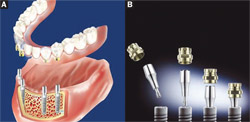 | 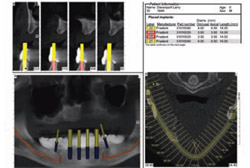 | |
| Figure 1A and Figure 1B The SynCone concept allows for immediate loading. | Figure 2 Treatment planning was based on Simplant results. | |
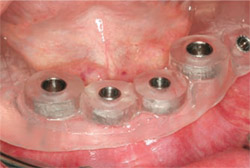 | 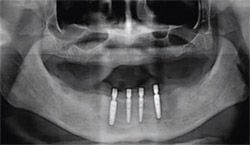 | |
| Figure 3 Materialise tissue-borne surgical guide in place. | Figure 4 Postoperative panorex. | |
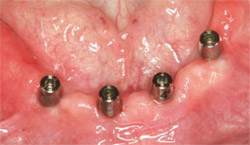 | ||
| Figure 5 Healing response at 3 weeks postsurgery. The successful outcome has been life-changing for the patient. |



